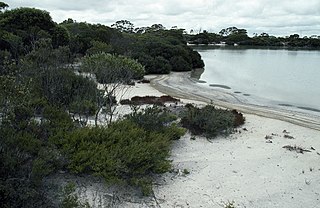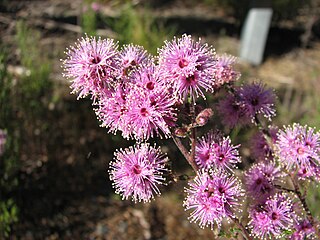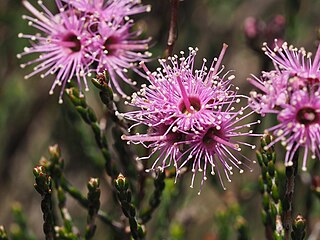
Leptospermum scoparium, commonly called mānuka, mānuka myrtle, New Zealand teatree, broom tea-tree, or just tea tree, is a species of flowering plant in the myrtle family Myrtaceae, native to New Zealand and south-east Australia. Its nectar produces Mānuka honey.

Kunzea ericoides, commonly known as kānuka, kanuka, or white tea-tree, is a tree or shrub in the myrtle family, Myrtaceae and is endemic to New Zealand. It has white or pink flowers similar to those of Leptospermum and from its first formal description in 1832 until 1983 was known as Leptospermum ericoides. The flowers have five petals and up to 25 stamens which are mostly longer than the petals.

Kunzea is a genus of plants in the family Myrtaceae and is endemic to Australasia. They are shrubs, sometimes small trees and usually have small, crowded, rather aromatic leaves. The flowers are similar to those of plants in the genus Leptospermum but differ in having stamens that are longer than the petals. Most kunzeas are endemic to Western Australia but a few occur in eastern Australia and a few are found in New Zealand. The taxonomy of the genus is not settled and is complicated by the existence of a number of hybrids.

Kunzea salina is a species of flowering plant in the myrtle family, Myrtaceae and is endemic to the south of Western Australia. It is a low, spreading, densely branched shrub with leaves mostly arranged in opposite pairs and usually two sessile pale pink to white flowers arranged at the base of new shoots. It only grows near the edge of certain salt lakes.
Kunzea glabrescens, commonly known as spearwood, is a flowering plant in the myrtle family, Myrtaceae and is endemic to the south-west of Western Australia. It is a large shrub with leaves and flowers similar to those of K. ericifolia but has differently shaped bracteoles. It is often common in wet areas around Perth.
Kunzea peduncularis, commonly known as mountain burgan, is a flowering plant in Myrtaceae, the myrtle family, and is endemic to Victoria, Australia. It is usually a dense shrub and has lance-shaped to egg-shaped leaves with the narrower end towards the base. Dense groups of white flowers appear in early summer.

Kunzea parvifolia, commonly known as the violet kunzea, is a flowering plant in the myrtle family, Myrtaceae and is endemic to eastern Australia. It is a wiry shrub with small, narrow leaves and clusters of pink to purple flowers in spring.

Kunzea montana, commonly known as mountain kunzea, is a flowering plant in the myrtle family, Myrtaceae and is endemic to the south-west of Western Australia. It is a shrub or small tree with more or less round leaves and heads of cream-coloured to pale yellow flowers on the ends of the branches in late spring. It is an uncommon species, growing on rocky mountain slopes, but all populations are conserved in the Stirling Range National Park.

Kunzea clavata, commonly known as the Torbay spearwood, is a flowering plant in the myrtle family, Myrtaceae and is endemic to a small area on the south coast of Western Australia. It is a shrub or tree, typically with many branches and grows to a height of 2.5 to 4 metres. It blooms between September and October producing yellow flowers.

Kunzea amathicola, also known by the Maori names manuka and rawiritoa, is a flowering plant in the myrtle family, Myrtaceae and is endemic to New Zealand. It is a densely-branched, densely-foliaged large shrub or tree with sprays of large white flowers with a red centre.

Kunzea axillaris is a flowering plant in the myrtle family, Myrtaceae and is endemic to a small area of New South Wales. It is an erect shrub or tree with linear leaves and white flowers which are arranged singly in leaf axils. It is only known from the ranges on the north coast.
Kunzea calida is a plant in the myrtle family, Myrtaceae and is endemic to Queensland, Australia. It is a spreading shrub which has linear to lance-shaped leaves but which are rolled, making them appear cylindrical. The flowers are pinkish-purple and arranged in groups near the ends of the branches in September. It is only known in remote and rugged areas of the Mount Stewart Ranges near Homestead.

Kunzea flavescens is a plant in the myrtle family, Myrtaceae and is endemic to Queensland. It is a spreading shrub which has egg-shaped leaves and groups of white or cream-coloured flowers on the ends of the branches in September and October.

Kunzea graniticola is a plant in the myrtle family, Myrtaceae and is endemic to Queensland. It is a shrub or small tree with linear to egg-shaped leaves and rounded groups of white or cream-coloured flowers on the ends of the branches in August and September. It is only known from forests near Cardwell and on Hinchinbrook Island.

Kunzea leptospermoides, commonly known as Yarra burgan, is a flowering plant in Myrtaceae, the myrtle family, and is endemic to Victoria, Australia. It is an erect shrub or small tree with narrow leaves and white flowers crowded near the ends of the branches in spring.

Kunzea opposita is a plant in the myrtle family, Myrtaceae and is endemic to eastern Australia. It is a spindly shrub which has small leaves arranged in opposite pairs, and pink flowers with five petals and many stamens, the stamens much longer than the petals. It usually grows in woodland or on exposed cliffs.

Kunzea robusta, commonly known as rawirinui or kanuka, is a tree in the myrtle family, Myrtaceae, and is endemic to New Zealand. It has rough, stringy, or corky bark, lance-shaped leaves that are darker on the upper surface, flowers in compact groups of up to 30, each with five or six white petals, and about 35 stamens of varying lengths.

Kunzea salterae, also known by the Maori name moutohora kanuka, is a flowering plant in the myrtle family, Myrtaceae and is endemic to Moutohora Island in New Zealand. It is a much-branched shrub or small spreading tree with needle-like leaves, sprays of white flowers and small cup-shaped or urn-shaped fruit.
Kunzea sericothrix is a plant in the myrtle family, Myrtaceae and is endemic to Queensland. It is a small shrub with linear to lance-shaped leaves. It is only known from a single collection, and the details of its flowers are provisional.

Leptospermum brachyandrum is a species of shrub or small tree that is endemic to eastern Australia. It has smooth bark, linear to lance-shaped leaves and white flowers and usually grows along creeks, often in water.


















